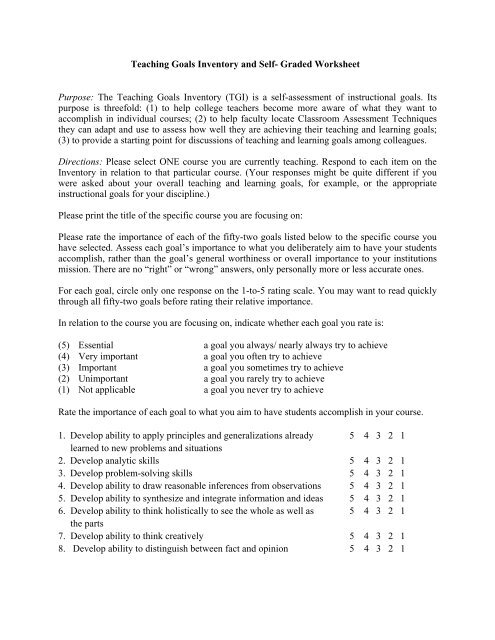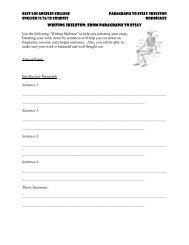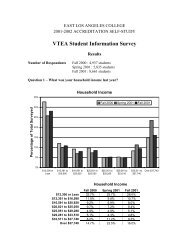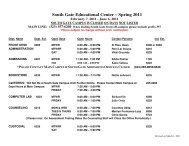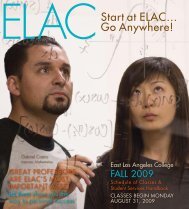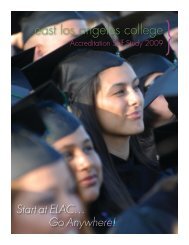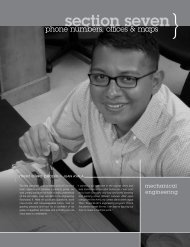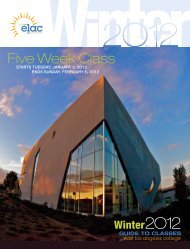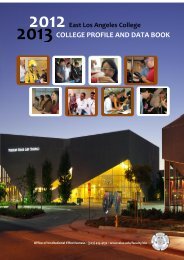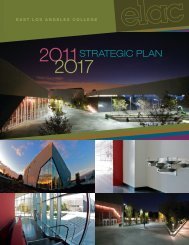The Teaching Goals Inventory (TGI) is a self-assessment of instruct
The Teaching Goals Inventory (TGI) is a self-assessment of instruct
The Teaching Goals Inventory (TGI) is a self-assessment of instruct
You also want an ePaper? Increase the reach of your titles
YUMPU automatically turns print PDFs into web optimized ePapers that Google loves.
<strong>Teaching</strong> <strong>Goals</strong> <strong>Inventory</strong> and Self- Graded WorksheetPurpose: <strong>The</strong> <strong>Teaching</strong> <strong>Goals</strong> <strong>Inventory</strong> (<strong>TGI</strong>) <strong>is</strong> a <strong>self</strong>-<strong>assessment</strong> <strong>of</strong> <strong>instruct</strong>ional goals. Itspurpose <strong>is</strong> threefold: (1) to help college teachers become more aware <strong>of</strong> what they want toaccompl<strong>is</strong>h in individual courses; (2) to help faculty locate Classroom Assessment Techniquesthey can adapt and use to assess how well they are achieving their teaching and learning goals;(3) to provide a starting point for d<strong>is</strong>cussions <strong>of</strong> teaching and learning goals among colleagues.Directions: Please select ONE course you are currently teaching. Respond to each item on the<strong>Inventory</strong> in relation to that particular course. (Your responses might be quite different if youwere asked about your overall teaching and learning goals, for example, or the appropriate<strong>instruct</strong>ional goals for your d<strong>is</strong>cipline.)Please print the title <strong>of</strong> the specific course you are focusing on:Please rate the importance <strong>of</strong> each <strong>of</strong> the fifty-two goals l<strong>is</strong>ted below to the specific course youhave selected. Assess each goal’s importance to what you deliberately aim to have your studentsaccompl<strong>is</strong>h, rather than the goal’s general worthiness or overall importance to your institutionsm<strong>is</strong>sion. <strong>The</strong>re are no “right” or “wrong” answers, only personally more or less accurate ones.For each goal, circle only one response on the 1-to-5 rating scale. You may want to read quicklythrough all fifty-two goals before rating their relative importance.In relation to the course you are focusing on, indicate whether each goal you rate <strong>is</strong>:(5) Essential a goal you always/ nearly always try to achieve(4) Very important a goal you <strong>of</strong>ten try to achieve(3) Important a goal you sometimes try to achieve(2) Unimportant a goal you rarely try to achieve(1) Not applicable a goal you never try to achieveRate the importance <strong>of</strong> each goal to what you aim to have students accompl<strong>is</strong>h in your course.1. Develop ability to apply principles and generalizations already 5 4 3 2 1learned to new problems and situations2. Develop analytic skills 5 4 3 2 13. Develop problem-solving skills 5 4 3 2 14. Develop ability to draw reasonable inferences from observations 5 4 3 2 15. Develop ability to synthesize and integrate information and ideas 5 4 3 2 16. Develop ability to think hol<strong>is</strong>tically to see the whole as well as 5 4 3 2 1the parts7. Develop ability to think creatively 5 4 3 2 18. Develop ability to d<strong>is</strong>tingu<strong>is</strong>h between fact and opinion 5 4 3 2 1
________________________________________________________________________9. Improve skill at paying attention 5 4 3 2 110. Develop ability to concentrate 5 4 3 2 111. Improve memory skills 5 4 3 2 112. Improve l<strong>is</strong>tening skills 5 4 3 2 113. Improve speaking skills 5 4 3 2 114. Improve reading skills 5 4 3 2 115. Improve writing skills 5 4 3 2 116. Develop appropriate study skills, strategies, and habits 5 4 3 2 117. Improve mathematical skill 5 4 3 2 1________________________________________________________________________18. Learn terms and facts <strong>of</strong> th<strong>is</strong> subject 5 4 3 2 119. Learn concepts and theories in th<strong>is</strong> subject 5 4 3 2 120. Develop skill in using materials, tools, and/or technology central 5 4 3 2 1to th<strong>is</strong> subject21. Learn to understand perspectives and values <strong>of</strong> th<strong>is</strong> subject 5 4 3 2 122. Prepare for transfer or graduate study 5 4 3 2 123. Learn techniques and methods used to gain new knowledge in 5 4 3 2 1th<strong>is</strong> subject24. Learn to evaluate methods and materials in th<strong>is</strong> subject 5 4 3 2 125. Learn to appreciate important contributions to th<strong>is</strong> subject 5 4 3 2 1_________________________________________________________________________26. Develop an appreciation <strong>of</strong> the liberal arts and sciences 5 4 3 2 127. Develop an openness to new ideas 5 4 3 2 128. Develop an informed concern about contemporary social <strong>is</strong>sues 5 4 3 2 129. Develop a commitment to exerc<strong>is</strong>e the rights and responsibilities 5 4 3 2 1<strong>of</strong> citizenship30. Develop a lifelong love <strong>of</strong> learning 5 4 3 2 131. Develop aesthetic appreciations 5 4 3 2 132. Develop an informed h<strong>is</strong>torical perspective 5 4 3 2 133. Develop an informed understanding <strong>of</strong> the role <strong>of</strong> science and 5 4 3 2 1technology34. Develop an informed appreciation <strong>of</strong> other cultures 5 4 3 2 135. Develop capacity to make informed ethical choices 5 4 3 2 1__________________________________________________________________________36. Develop ability to work productively with others 5 4 3 2 137. Develop management skills 5 4 3 2 138. Develop leadership skills 5 4 3 2 139. Develop a commitment to accurate work 5 4 3 2 140. Improve ability to follow directions, <strong>instruct</strong>ions, and plans 5 4 3 2 141. Improve ability to organize and use time effectively 5 4 3 2 142. Develop a commitment to personal achievement 5 4 3 2 143. Develop ability to perform skillfully 5 4 3 2 1___________________________________________________________________________
44. Cultivate a sense <strong>of</strong> responsibility for one’s own behavior 5 4 3 2 145. Improve <strong>self</strong>-esteem/<strong>self</strong>-confidence 5 4 3 2 146. Develop a commitment to one’s own values 5 4 3 2 147. Develop respect for others 5 4 3 2 148. Cultivate emotional health and well-being 5 4 3 2 149. Cultivate physical health and well-being 5 4 3 2 150. Cultivate an active commitment to honesty 5 4 3 2 151. Develop capacity to think for one<strong>self</strong> 5 4 3 2 152. Develop capacity to make w<strong>is</strong>e dec<strong>is</strong>ions 5 4 3 2 153. In general, how do you see your primary role as a teacher? (Although more than onestatement may apply, please circle only one.)______________________________________________________________________________1 <strong>Teaching</strong> students facts and principles <strong>of</strong> the subject matter2 Providing a role model for students3 Helping students develop higher-order thinking skills4 Preparing students for jobs/careers5 Fostering student development and personal growth6 Helping students develop basic learning skillsSource: Classroom Assessment Techniques, by Thomas A. Angelo and K. Patricia Cross.Copyright © 1993. Perm<strong>is</strong>sion to reproduce <strong>is</strong> hereby granted.<strong>Teaching</strong> <strong>Goals</strong> <strong>Inventory</strong>, Self-Scoring Worksheet1. In all, how many <strong>of</strong> the fifty-two goals did you rate as “Essential”? _________2. How many “Essential” goals did you have in each <strong>of</strong> the six clusters l<strong>is</strong>ted below?Total Number Clusters Ranked<strong>Goals</strong> <strong>of</strong> “Essential” from 1 st to 6 thCluster Number and Name Included <strong>Goals</strong> in by Number <strong>of</strong>in Cluster Each Cluster “Essential” <strong>Goals</strong>I Higher-Order 1-8 _____________ _______________Thinking SkillsII Basic Academic 9-17 _____________ _______________Success Skills
III D<strong>is</strong>cipline-Specific 18-25 _____________ _______________Knowledge and SkillsIV Liberal Arts and 26-35 _____________ _______________Academic ValuesV Work and Career 36-43 _____________ _______________PreparationVI Personal 44-52 _____________ _______________Development____________________________________________________________________________3. Compute your cluster scores (average item ratings by cluster) using the followingworksheet.A B C D E__________________ _______ ___________ _______ ______Sum <strong>of</strong>Ratings Given Divide C YourCluster Number and Name <strong>Goals</strong> to <strong>Goals</strong> in by Th<strong>is</strong> ClusterIncluded That Cluster Number ScoresI Higher-Order 1-8 ___________ 8 ______Thinking SkillsII Basic Academic 9-17 ___________ 9 ______Success SkillsIII D<strong>is</strong>cipline-Specific 18-25 ___________ 8 ______Knowledge and SkillsIV Liberal Arts and 26-35 ___________ 10 ______Academic ValuesV Work and Career 36-43 ___________ 8 ______PreparationVI Personal 44-52 ___________ 9 ______DevelopmentSource: Classroom Assessment Techniques, by Thomas A. Angelo and K. Patricia Cross.Copyright © 1993. Perm<strong>is</strong>sion to reproduce <strong>is</strong> hereby granted.


